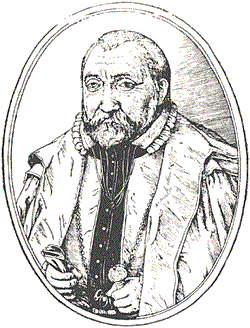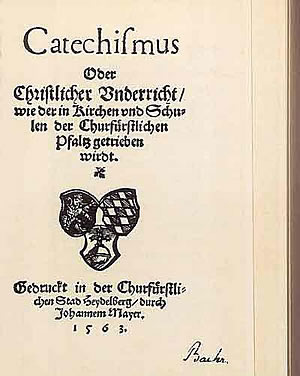10. The Electoral Palatinate and Baden
The Electoral Palatinate was considered up to the end of the 16th Century to be a completely Reformed territory and served as a model to be emulated by other regions and regional rulers in Germany. The Lutheran Reformation was introduced early on in many towns in the Palatinate (from 1526), and likewise in the part-region Zweibruecken (in 1533). In Heidelberg, Luther was able to win several over at the disputation in 1518 (e.g. Martin Bucer), and the knight Franz von Sickingen served as protector for several Protestant movements.

Kurfürst
Friedrich III
In the Electoral Palatinate as a whole, the Lutheran Reformation was carried through first under the Elector Frederick II (who ruled from 1544 to 1556), and then under his successor and nephew Ottheinrich (who ruled from 1556 to 1559). But this was a Lutheranism in the Electoral Palatinate with a number of different influences present. There were strict Lutherans, followers of Melanchthon (Philipp Melanchthon came from Bretten in the Palatinate after all), and indeed those who were of Reformed persuasion. After Ottheinrich’s brief reign, Frederick III – also named the Pious – became his successor. He ruled from 1559 to 1576. The Protestant orientations, ever drifting apart from one another, demanded Frederick III to profess his faith unambiguously in one confession. By now, the Reformed confession was not considered a force to be reckoned with in Germany, but was so considered in the whole of Europe. His own theological education and the Disputation of Heidelberg in 1560 concerning the Lord’s Supper led him to become Reformed. His inclination towards the Reformed understanding of the Lord’s Supper, his growing theological critique of Luther, and the presence of polemical “Lutherans” in Heidelberg also contributed to this. The Electoral Palatinate was thus the first Protestant Reformed territory. The Heidelberg Catechism, completed in 1563, in the context of the new Church Constitution of the Palatinate, was the document of this new orientation in the Palatinate. Frederick III himself had collaborated on it, but the chief author was the Heidelberg professor of theology, Zacharias Ursinus. Although the Heidelberg Catechism is regarded world-wide as one of the most important Reformed confessional writings, it must nevertheless be noted that it continually attempts to integrate Lutheran concerns. Certain important concerns of Calvin are lacking (like the doctrine of predestination).

Faksimile
Heidelberger Katechismus
Echoes of Luther’s Small Catechism and Calvin’s
Geneva Catechism can be discerned in many places. After its introduction in
the Palatinate, the Heidelberg Catechism gradually became the most important
and binding confession in German Reformed territories, and became native even
outside Germany, e.g. in the Netherlands. During the time of his reign, Frederick
III built up the Heidelberg University into one of the most important centres
of Reformed theology. The numerous foreign students there demonstrated Heidelberg’s
power of attraction.
After Frederick’s death in 1576, his son Louis II (who ruled from 1576
to 1583) caused once more a change of direction towards Lutheranism. The Reformed
teachers emigrated for seven years to Neustadt in the Haardt, where John Casimir,
a brother of Louis II, reigned. Besides Ursinus, the influential Girolamo Zanchi,
originally from Italy, was among those who had an effect in Neustadt. The Lutheran
episode nevertheless came to an end after the early death of Louis II. John
Casimir now ruled in Heidelberg as well, and the Electoral Palatinate was a
Reformed region once more. It attracted Walloon and French refugees (having
fled on account of their faith). Both under Frederick III and John Casimir
refugee congregations arose.
In Baden, unlike in the Electoral Palatinate, there was only one, if also notable,
Reformed interlude. The chief figure in this was the margrave Ernest Frederick,
who was theologically extremely well versed. The county of the margraves of
Baden-Durlach had joined the Reformation late, like the Electoral Palatinate.
The county was divided first into two regions in 1584, and then in 1590 into
three. Ernest Frederick obtained the lower half of the county (including Pforzheim
and Durlach), George Frederick the upper. Whereas George Frederick remained
Lutheran like his father, Ernest Frederick turned to the Reformed church – indeed
from an inner theological conviction. This became outwardly visible in 1599
when Ernest Frederick published a “Staffort book” which he had
written himself. Ernest Frederick demonstrates in this, on the one hand, that
he agreed with the Confessio Augustana (Augsburg Confession). On the other
hand, he investigates fundamental Reformed statements of faith (free will,
the providence of God, predestination, the person of Christ and the sacraments).
He interprets these basically in the light of Calvin and sees them at the same
time in continuity with the Confessio Augustana (even if not with the Lutheran
Formula of Concord). With this Staffort book, named after the castle in which
it was written and printed, a turn to the Reformed church took place in the
County of Baden-Durlach, but without anything changing legally, because the
Confessio Augustana was still valid.
In Pforzheim, however, this change came up against fierce protests, and Ernest
Frederick’s attempts at arbitration ended before they had even begun
because he suddenly died. After his death, his brother George Frederick took
over the rule, and so it appears that the Reformed confession in the County
of Baden-Durlach was only an interlude.
The formerly Reformed congregations in the Palatinate constitute today the
Protestant congregations in the “Protestant Church of the Palatinate
(Protestant Regional Church).”